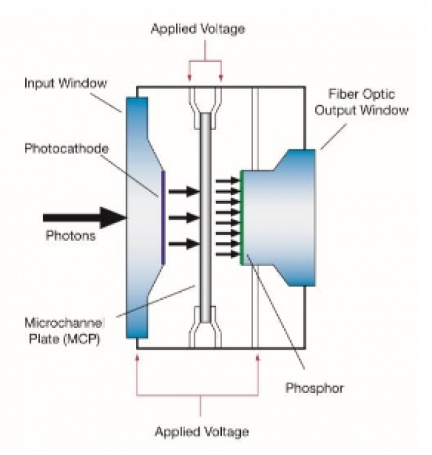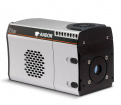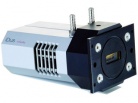The intensified CCD chip consists of two parts - a cooled CCD chip with low-noise electronics (small repetition rate of 50 - 500 kHz), in front of which a phosphorescent screen is placed, and an image intensifier, which is a special intensity multiplier of incident light that works on the principle of a conventional dynode photomultiplier, but in miniature size.
The chip can be thought of as a photocathode on which light radiation is incident and produces electrons which are further accelerated by an electric field and enter a microchannel photomultiplier (MCP = Micro Channel Photomultiplier) to which a fixed voltage is applied causing ICCD amplification and where the electrons are multiplied and re-accelerated by another electric field onto the phosphorescent screen. The cluster of electrons incident on the phosphorescent screen generates an optical flash, which is captured by a low-noise CCD chip connected to the screen by fibre optics - in the chip the light is converted into an electrical charge, which is then converted to image data by an analogue-to-digital converter.
The intensified CCD camera enables image capture at very low light levels over a wide light spectrum and at relatively high speeds. Thanks to the image intensifier, the sensitivity can be increased to the level of single photons, which can then be detected. In addition to the high sensitivity, the ICCD chips also have the advantage of fast switching of the voltage on the photocathode (gating) acting as an electronic shutter. Using a suitable short voltage pulse, the amplifier can be switched on and off efficiently at intervals of under a nanosecond. The quantum efficiency (QE) of an ICCD depends on the type of photocathode used - the QE value decreases in the amplification process, in the transmission through optical fibers, and by the efficiency of the CCD chip.
In conjunction with a spectrograph, the ICCD can also measure the spectrum of the detected radiation. It is therefore used in spectroscopic measurements requiring high temporal resolution (nanoseconds), e.g. in semiconductor research, laser development, optical communication, etc.



